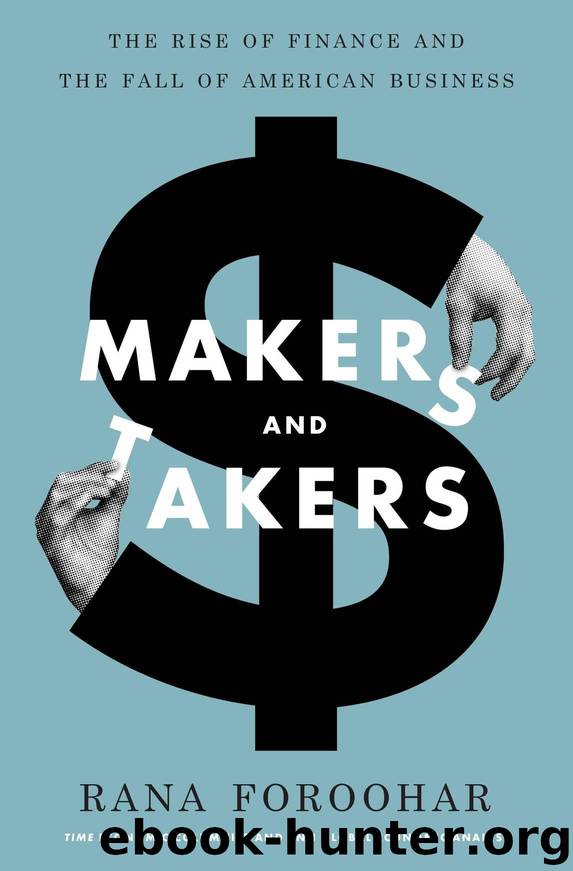Makers and Takers: The Rise of Finance and the Fall of American Business by Rana Foroohar

Author:Rana Foroohar [Foroohar, Rana]
Language: eng
Format: epub, mobi, azw3
Tags: Business & Economics, Economic Conditions, tecnicos
ISBN: 9780553447231
Publisher: Crown Business
Published: 2016-05-17T03:00:00+00:00
“I’m sure that Goldman used the information they had about aluminum to influence the market between 2010 and 2013,” says Cornell law professor Saule Omarova. (Her paper on the problems inherent in banks both owning and trading commodities, “The Merchants of Wall Street: Banking, Commerce, and Commodities,” first sparked serious media interest in the topic.) “But can I prove it? No. Can the CFTC? I doubt it. And if that’s the case, should Goldman be doing any of this? Absolutely not.”22
Part of the complexity of the commodities-linked derivatives markets, like derivatives trading markets as a whole, is that until quite recently they weren’t subject to very much federal oversight. According to former CFTC head Gary Gensler, also a former Goldman Sachs derivatives expert (and now CFO of Hillary Clinton’s presidential campaign), prior to the 2008 crisis around 90 percent of the entire derivatives market was in an unregulated space, not subject to oversight or central clearing on public exchanges.23 Gensler, who made it his business while at the CFTC to try to change that, has special insight into just how damaging that opacity can be. In 1998, while working in the Clinton administration for then–Treasury secretary Robert Rubin, he was assigned the task of trying to sort out the potential financial implications of the implosion of the hedge fund Long-Term Capital Management (LTCM). The culprit: a $1.25 trillion swaps portfolio gone bad. Gensler remembers going out to LTCM’s headquarters in Greenwich, Connecticut, on a Sunday to investigate. “It quickly became clear to me that we had no idea what the ramifications would be in our financial system, and where, because these trades were booked in the Cayman Islands,” he says. “It was a terrible feeling.”24
Derivatives—be they interest rate swaps, foreign exchange bets, or energy futures—have real-world impacts, as we’ve already seen. Yet to the banks, hedge funds, and the other institutions that trade them, they are simply another moneymaking vehicle, something to be bought and sold. What’s more, most of us play a part in the cycle that drives up commodity prices and disproportionately enriches the financial sector, via our retirement savings. After the bursting of the tech bubble, in the wake of the market downturn, institutional investors like pension funds and endowments, along with big asset managers like Fidelity, began looking for a new place to make money. Commodities markets had always been attractive to certain risk-taking speculators, but they weren’t typically a place where institutional investors would put their funds.25 Yet around 2004, as China’s energy needs were heating up and commodity prices were rising, a couple of Yale academics put out a paper heralding the virtues of commodities investing as a way to balance big portfolios, arguing that historically, commodities typically didn’t rise and fall in the same cycles as other assets such as stocks and bonds. It was a catalyst for many big asset managers to start getting into the commodities space. Amazingly, nobody thought too much about the fact that those academics had been funded
Download
Makers and Takers: The Rise of Finance and the Fall of American Business by Rana Foroohar.mobi
Makers and Takers: The Rise of Finance and the Fall of American Business by Rana Foroohar.azw3
This site does not store any files on its server. We only index and link to content provided by other sites. Please contact the content providers to delete copyright contents if any and email us, we'll remove relevant links or contents immediately.
The Secret History by Donna Tartt(18840)
The Social Justice Warrior Handbook by Lisa De Pasquale(12141)
Thirteen Reasons Why by Jay Asher(8791)
This Is How You Lose Her by Junot Diaz(6778)
Weapons of Math Destruction by Cathy O'Neil(6139)
Zero to One by Peter Thiel(5684)
Beartown by Fredrik Backman(5594)
The Myth of the Strong Leader by Archie Brown(5421)
The Fire Next Time by James Baldwin(5246)
How Democracies Die by Steven Levitsky & Daniel Ziblatt(5127)
Promise Me, Dad by Joe Biden(5087)
Stone's Rules by Roger Stone(5026)
100 Deadly Skills by Clint Emerson(4840)
A Higher Loyalty: Truth, Lies, and Leadership by James Comey(4840)
Rise and Kill First by Ronen Bergman(4701)
Secrecy World by Jake Bernstein(4640)
The David Icke Guide to the Global Conspiracy (and how to end it) by David Icke(4624)
The Farm by Tom Rob Smith(4434)
The Doomsday Machine by Daniel Ellsberg(4415)
